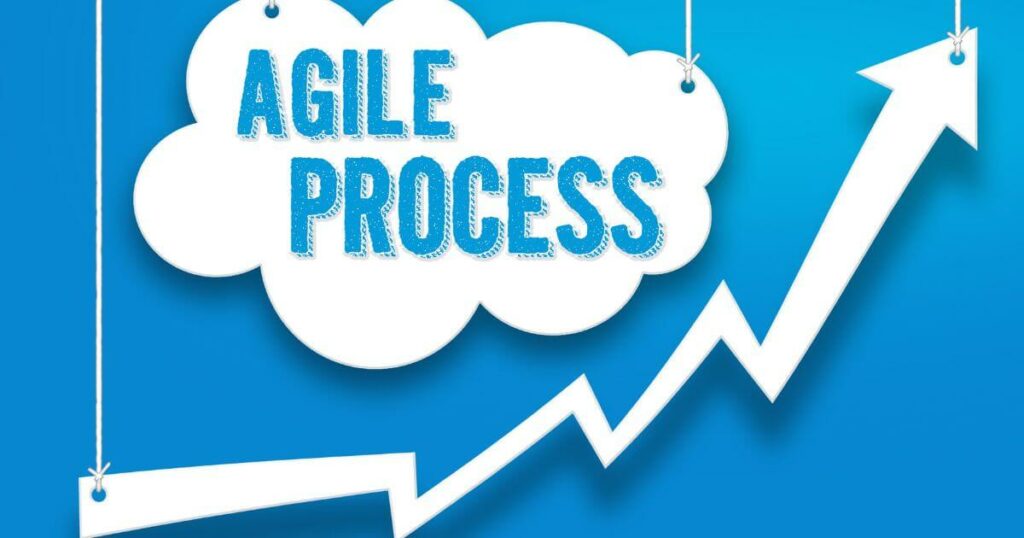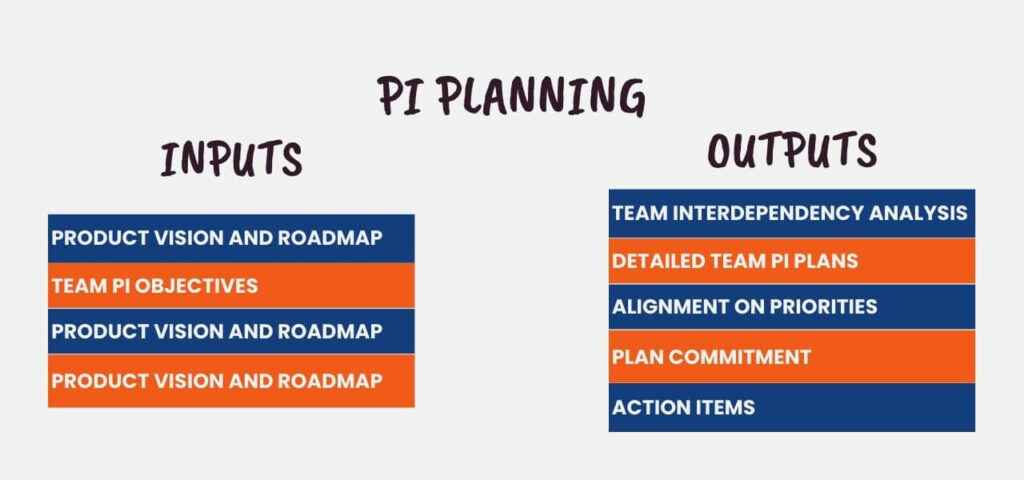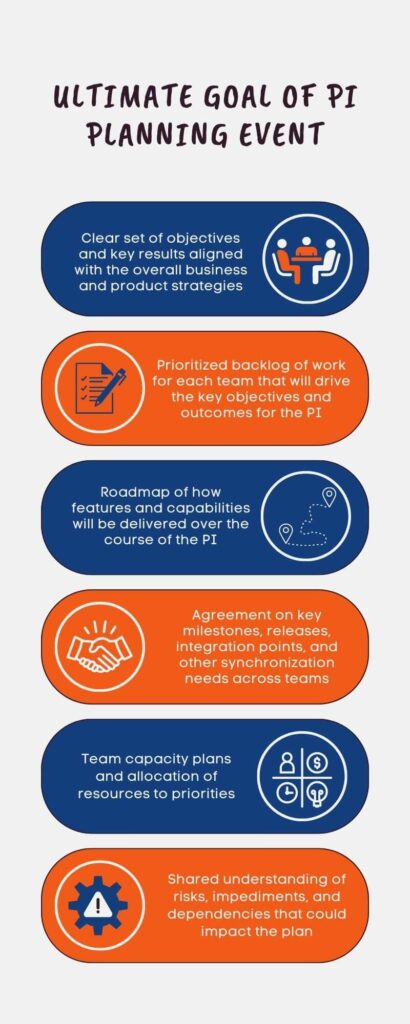The sprint is the heartbeat of any Agile team. But to keep that heart pumping at a steady pace, you need proper planning and vision.
That’s where Agile PI Planning comes in. PI Planning is a chance for the whole team to come together, review priorities, and map out the next 3-12 sprints.
It’s a workshop to gain alignment, clarify ambitions, and energize the team. Done right, PI Planning will chart the course for your Agile team’s success over the planning horizon.
What is PI Planning in Agile?
PI stands for Program Increment. PI Planning is a key event in Scaled Agile Framework (SAFe), where multiple teams within the same Agile Release Train (ART) come together to plan Program Increments, typically 8-12 sprints long.
In PI Planning, Agile teams, product managers, and architects converge to determine how functionality will be delivered over the planning horizon.
Each team shares its objectives, dependencies, and risks. Together they determine milestones and commitments for the next PI.
This helps identify resource constraints and dependencies across teams to coordinate deliverables. By the end, each team leaves with a plan for the next 3 months with clearly defined priorities, scope, and coordination to build releasable software every sprint.
PI Planning builds a shared vision and understanding to keep teams aligned as they build incremental solutions.

What is the Purpose of PI Planning?
PI planning serves several important purposes in Agile:
1. Alignment
PI planning brings together all the key stakeholders – teams, product managers, architects, executives, etc. This allows everyone to share their perspectives, priorities, goals, and plans.
This helps ensure alignment on the vision and roadmap for the next 3-12 months.
2. Coordination
Teams can identify dependencies and constraints across teams and plan accordingly. They coordinate release schedules, objectives, resources, etc.
This coordination is key to successfully delivering larger solutions.
3. Commitment
Teams commit to a set of priorities, scope, and milestones for the planning horizon. They determine how much functionality can be delivered based on velocity, past performance, team dynamics, and technical factors.
This shared commitment provides focus and accountability.
4. Risk Management
Teams discuss potential risks, obstacles, and issues that could impact deliverables. They determine risk mitigation plans to address them proactively. This is more effective than dealing with issues as they arise.
5. Continuous Improvement
Teams reflect on how to improve processes and performance based on past PIs. They determine experiments they want to try in the next PI to optimize value delivery. PI planning fosters an iterative, learning mindset.
6. Team Building
The in-person discussions and interactions during PI planning help strengthen relationships and trust within teams and across teams. Shared experiences build the foundation of a collaborative culture.
7. Product Visioning
PI planning typically involves leadership articulating the long-term product vision and plans. This helps motivate teams and aligns them with the broader organizational goals.
Teams can see how their efforts contribute to the overall vision.
8. Transparency
PI planning fosters transparency between teams, leadership, and stakeholders. Challenges, risks, dependencies, and progress are openly discussed.
This transparency builds trust and a shared understanding of program status.
9. Adaptability
Even though teams make initial commitments, they retain the agility to adapt as needed during the PI. Teams come together again at the end of the PI to evaluate progress, learn from experiences, and re-plan the next PI. This constant feedback and adaptation is key.
In summary, the purpose of PI planning is to gain alignment, make coordinated commitments, mitigate risks, drive continuous improvement, and build high-performing teams. It provides the roadmap for successful value delivery in Agile.
How to Conduct Agile PI Planning
1. Preparation
A successful Agile PI Planning event requires thorough preparation. Key stakeholders, including Product Managers, Release Train Engineers, System Architects, and Business Owners, should align on the vision, roadmap, and objectives for the upcoming PI.
They should also gather any necessary input from customers or external stakeholders, identify potential risks, and prepare any necessary materials for the event.
2. Setting the Context
At the beginning of the Agile PI Planning event, it’s essential to set the context for the upcoming PI. The Product Manager presents the program vision, the roadmap, and the objectives for the PI.
This helps to ensure that all teams are on the same page and understand the broader context in which they will be working.
3. Breakout Sessions
During the breakout sessions, individual teams work together to plan their work for the upcoming PI. They create a draft of their PI objectives, identify any dependencies or risks, and estimate the effort required for each feature or user story.
Teams should also discuss their capacity for the upcoming PI, taking into account any planned vacations or other factors that may impact their ability to deliver.
4. Cross-Team Review
After the breakout sessions, teams come together to review their draft PI objectives and discuss any dependencies or risks. This cross-team review helps to ensure that all teams are aligned and working towards a common goal.
Any conflicts or issues that arise during this review should be addressed and resolved to ensure a successful PI.
5. Finalizing PI Objectives and Commitment
Once all teams have reviewed and agreed upon their PI objectives, they finalize their objectives and make a commitment to deliver on them during the upcoming PI.
This commitment helps to ensure accountability and encourages teams to stay focused on delivering value.
6. Retrospective and Continuous Improvement
After the Agile PI Planning event, it’s essential to hold a retrospective to reflect on the process and identify areas for improvement.
This continuous improvement mindset is a core principle of Agile and helps to ensure that each PI Planning event is more effective and efficient than the last.
Tips for a Successful Agile PI Planning Event
1. Prepare in Advance
A successful PI planning event requires preparation and planning in the weeks leading up to the event.
Make sure all teams have completed their PI objectives and key results (OKRs) and have a rough roadmap for what they want to achieve in the next PI.
Have teams also review their capacity and ensure there are no foreseeable obstacles.
2. Ensure Full Attendance
PI planning is a collaborative event, so make attendance mandatory for all team members. This includes developers, testers, UX designers, Product Owners, Scrum Masters, and relevant stakeholders.
Have a schedule for who needs to attend which parts of the planning to make the best use of everyone’s time.
3. Start with the Big Picture
On the first day of planning, start with an overview of the key priorities, objectives, and outcomes for the overall program and product.
Share details on the key features, themes, and roadmap items expected in the next PI. This helps provide context for all the teams as they go into their detailed team planning.
4. Focus on Team Collaboration
The bulk of the planning event should be focused on individual team breakout sessions.
Teams should work together on their PI roadmap, go through stories and backlogs, identify dependencies, and have open discussions.
Teams should also share their plans with other teams to identify cross-team dependencies or integration needs. The goal is building a coordinated plan across teams.
5. Leave Time for Follow Ups
While teams should aim to complete most of their planning and roadmapping during the dedicated days for the event, also leave time for follow-ups.
Teams may need extra time after the initial event to refine details, adjust timelines, or work on resolving additional dependencies.
Planning is iterative, so the days after the main event are also important for working out a comprehensive plan.
Challenges that can Arise During PI Planning
Some common challenges that can arise during PI planning include:
1. Lack of Clarity in Product Vision
If the overall product vision and roadmap are not clear, teams may struggle to align their plans. Leadership needs to articulate a compelling vision.
2. Too much Ambition
Teams may be overambitious in what they commit to deliver during the PI. This can lead to unrealistic plans that will not be achieved. Teams need to estimate realistically based on their capacity.
3. Poor Cross-team Coordination
Teams may fail to coordinate effectively with each other, resulting in gaps, dependencies, and risks that are missed during planning. Strong facilitation is needed to enable cross-team coordination.
4. Conflicts or Lack of Cooperation
There may be conflicts, power struggles, or lack of trust between teams that prevent effective planning. Healthy team dynamics and a cooperative culture must exist before large-scale planning.
5. Constantly Changing Priorities
If new priorities or requirements keep changing frequently during planning, it becomes difficult for teams to achieve alignment and commitment. Some level of stability is needed for effective PI planning.
6. Too much Tactical Thinking
Teams may focus too much on low-level tactical details during planning rather than strategic, high-level thinking. Guidance is needed to maintain the right planning level.
7. Reliance on Upfront Planning
Some teams may feel that the upfront PI planning is set in stone and there is no room for adaptation. But Agile PI planning needs to enable continuous feedback and adjustment to changes.
Teams must plan with the expectation that adaptation will be needed.
8. Lack of Data to Support Planning
If teams do not have visibility into metrics, progress, risks, quality issues, etc. it becomes difficult for them to plan effectively.
Relevant data and metrics must be available to support PI planning discussions and decision-making.
9. Disengaged Participants
Participants who attend planning but are not truly engaged can reduce the effectiveness. Active participation and contribution from all attendees are important for success.
These are some of the most significant challenges teams should watch out for and mitigate during PI planning. With experience, teams get better at running effective PI planning events.

What are the Steps in PI Planning?
PI Planning is the event where Agile teams come together to plan and synchronize their work for the upcoming Program Increment (PI). It follows a structured process with clear steps:
- Review Vision and Roadmap: The leadership team reviews the vision and roadmap for the overall product to ensure all teams are aligned on the direction and priorities for the next PI.
They discuss any changes in the market or with customers that influence the roadmap. - Share Team PI Objectives: Each team shares their key objectives for the next PI based on the roadmap. They outline their goals and any new features or expected outcomes. The other teams ask questions or provide input to ensure there are no gaps or dependencies.
- Identify Team Interdependencies: The teams meet with each other to determine if there any interdependencies between their PI Objectives.
They outline what they expect from other teams and identify any risks to collaboration or integration points. Action items are captured to sync up on a regular basis. - Finalize Team PI Plans: Each team reviews their PI Objectives and interdependencies, then proceeds to build out their detailed plans for the next PI.
They account for capacity, story point estimates, tasks, and the work they have selected to achieve their objectives. - Review and Commit: The leadership team reviews each team’s PI Plan and provides feedback. Teams then commit to their plans for the next PI and confidently move into execution knowing they have a clear and shared understanding of the work ahead.
PI Planning is key to achieving alignment, breaking down silos, and maintaining a shared commitment to the PI Objectives.
When done well, it leads to the most productive PIs with motivated teams and accelerated product development.

Inputs and Outputs of PI Planning
PI Planning requires several key inputs to be effective:
- Product Vision and Roadmap: The leadership team establishes a clear vision and roadmap for the product to steer the planning discussions. The roadmap outlines the key features and milestones for the next 6-12 months.
- Team PI Objectives: Each team proposes 2-3 key objectives they want to achieve in the upcoming PI based on the roadmap. These objectives drive their planning process.
- Capacity Calculations: Teams determine their velocity from the previous PI and estimate their capacity for the next PI based on time off and other considerations. This helps them decide how much work they can commit to.
- Story Points and Estimates: Teams review their backlogs and estimate any new stories to understand the level of effort involved. These estimates feed into their capacity calculations.
The major outputs from PI Planning include:
- Team Interdependency Analysis: Teams capture any dependencies and interactions between their PI Objectives. Risks are identified and collaboration points are planned.
- Detailed Team PI Plans: Each team builds out specific tasks, estimates, assignments, and schedules to achieve their PI Objectives based on their capacity. Their plan is committed to at the end of PI Planning.
- Alignment on Priorities: There is a shared understanding of the priorities and key focus areas for the product across all teams as captured in the PI Objectives and team plans. Alignment leads to integration and less re-work.
- Commitment to the Plan: Teams are motivated and committed to their plans as they were deeply involved in the planning process. Leadership also commits to supporting the teams in execution.
- Action Items: Any open questions, risks, or issues captured during the planning process are assigned as action items to be closed after PI Planning ends.
The inputs and outputs of PI Planning tie directly together to build cohesion across the teams and confidence in the path forward for the next PI.
When done right, you have set the foundation for successful execution over the next 3 months.

What is the Ultimate Goal of the PI Planning Event?
The ultimate goal of the PI planning event is to create an integrated plan for the upcoming Program Increment (PI) period. This means coming out of the event with:
- A clear set of objectives and key results (OKRs) that align with the overall business and product strategies. The OKRs provide focus and guidance for what needs to be achieved in the next 3-12 weeks.
- A prioritized backlog of work for each team that will drive the key objectives and outcomes for the PI. The backlogs should be refined and ready for teams to begin working on immediately following the planning event.
- A roadmap of how features and capabilities will be delivered over the course of the PI. The roadmap helps identify dependencies across teams and ensures work is coordinated. It also provides visibility to stakeholders on what is planned for delivery.
- Team capacity plans and allocation of resources to priorities. Each team evaluates their capacity for the PI and determines how to best allocate themselves across priorities to achieve their OKRs.
- Agreement on key milestones, releases, integration points, and other synchronization needs across teams. Getting alignment on these cross-team events is key to successful delivery at the end of the PI.
- Shared understanding of risks, impediments, and dependencies that could impact the plan. Discussing these issues openly at planning helps raise awareness so they can be addressed quickly.
- A sense of confidence and enthusiasm for what can be achieved. A successful planning event will energize teams and leave them feeling motivated for the work that lies ahead in the next PI.
So in summary, the ultimate goal of PI planning is putting in place a synchronized plan for successful execution and delivery over the course of the next Program Increment.
Achieving these outcomes sets up teams for productivity and progress during the PI.
Conclusion
Agile PI Planning is a crucial event in the Scaled Agile Framework that helps organizations align their Agile teams and ensure that they are working towards a shared vision and goals.
By understanding the purpose, benefits, and process of Agile PI Planning, organizations can successfully implement this event and enjoy the improved collaboration, enhanced transparency, and higher quality outcomes that it delivers.
Remember to involve the right people, create a conducive environment, encourage open communication, be flexible and adaptable, and focus on continuous improvement to ensure the success of your Agile PI Planning events.
FAQs
During PI Planning who owns the Feature Priorities?
During PI (Program Increment) Planning, the Product Manager owns the Feature Priorities.
Is there PI Planning in Scrum?
No, PI (Program Increment) planning is not a part of Scrum. PI planning is a concept from the Scaled Agile Framework (SAFe), which is designed for scaling Agile methodologies across large organizations. Scrum focuses on small, cross-functional teams working in time-boxed iterations called Sprints.
Who Facilitates PI Planning in Agile?
The facilitator of PI Planning in Agile is typically the Release Train Engineer (RTE). The RTE is responsible for guiding and coordinating the activities during the PI (Program Increment) planning event, ensuring effective communication and collaboration among cross-functional Agile teams.
How Often do you do PI planning in Agile?
In Agile, PI (Program Increment) planning is typically conducted every 8 to 12 weeks.





